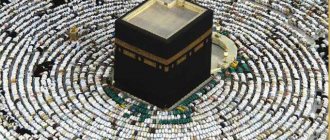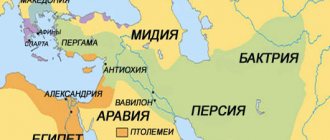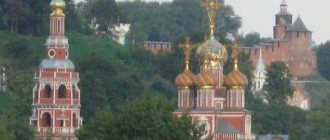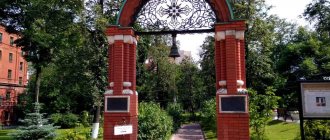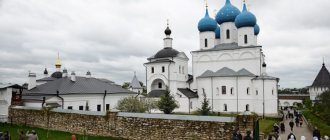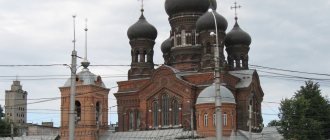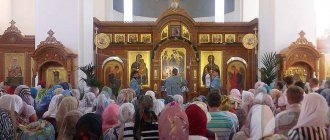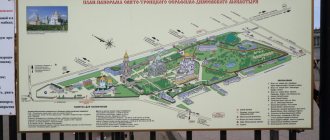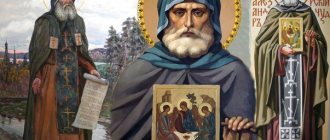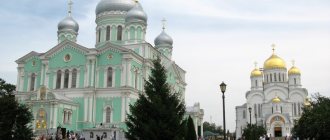| Stavropol diocese | |
| A country | Russia |
| Church | Russian Orthodox Church |
| Metropolis | Stavropolskaya |
| Date of foundation | 1842 |
| Control | |
| Main city | Stavropol |
| Cathedral | Kazan Cathedral (Stavropol) |
| Hierarch | Metropolitan of Stavropol and Nevinnomyssk Kirill (Pokrovsky) (since March 22, 2011) |
| Statistics | |
| Deanery | 14 |
| Map | |
| stavropol-eparhia.ru | |
| Media files on Wikimedia Commons | |
The Stavropol diocese
is a diocese of the Russian Orthodox Church with its center in the city of Stavropol. Covers part of the territory of the Stavropol Territory.
Titles
- Caucasian and Black Sea (July 17, 1842 - July 30, 1867)
- Caucasian and Ekaterinodar (July 30, 1867 - March 8, 1886)
- Stavropol and Ekaterinodar (March 8, 1886 - October 5, 1916)
- Caucasian and Stavropol (October 5, 1916-1922)
- Stavropol and Kuban (1922-1934)
- Stavropol and Don (1935-1943)
- Stavropol and Pyatigorsk (1943-1945)
- Stavropol and Baku (1945-1994)
- Stavropol and Vladikavkaz (1994-2011)
- Stavropol and Nevinnomyssk (since March 22, 2011)
Nevinnomyssk deanery
With the blessing of His Eminence Kirill,
Metropolitan of Stavropol and Nevinnomyssk
The pilgrimage service "City of the Cross" organizes trips:
MARCH 24 - 27 - to the blessed Matrona of Moscow and St. Sergius of Radonezh
Moscow city. Pokrovsky Convent . Relics of St. blzh. Matrona of Moscow. Icon of the Mother of God “Seeking the Lost.” Novospassky Monastery. Icon of the Mother of God “Vsetsaritsa”. Donskoy Monastery. Relics of St. Tikhon, Patriarch of All Russia. Icon of the Mother of God “Donskaya”.
Sergiev Posad. Trinity-Sergius Lavra . The relics of St. Sergius of Radonezh.
Zadonsk. Nativity of the Virgin Mary Monastery . Relics of St. Tikhon of Zadonsky.
________________________________
APRIL 14 - 17 - to St. Seraphim of Sarov
Murom. Holy Trinity Novodevichy Convent. The relics of the blgvv. knn. Peter and Fevronia of Murom. Spaso-Preobrazhensky Monastery. The miraculous icon of the Mother of God “Quick to Hear”.
With. Diveevo. Holy Trinity Seraphim-Diveevo Convent. The relics of St. Seraphim of Sarov. The Virgin's groove. Holy spring.
With. Vysha. Holy Dormition Convent. Relics of St. Theophan the Recluse.
Voronezh. Annunciation Cathedral. Relics of St. Mitrofan of Voronezh, sschmch. Peter, shrine with the relics of St. Tikhon of Zadonsky. Particularly revered icon of the Mother of God “Smolensk”. Alekseevo-Akatov convent.
________________________________
MAY - to the Holy Land
Jerusalem. Church of the Resurrection. Way of the Cross. Liturgy at the Holy Sepulcher.
Gethsemane. Tomb of the Mother of God. Garden of Gethsemane. Russian monastery.
Mount Zion. Upper room of the Last Supper.
Bethlehem. Church of the Nativity. Field of Shepherds. Monastery of St. St. Theodosius the Great.
Hebron. Mamvrian oak. Temple of the Holy Forefathers.
Jericho. Mount of Temptation.
Jordan. Monastery of St. Gerasimos of Jordan.
Nazareth. Temple of St. Archangel Gabriel over the source of the Mother of God.
Galilee. Cana of Galilee. Lake of Galilee. Monastery of the Twelve Apostles. Mount Tabor.
________________________________
MAY 20 - 28 - along the Golden Ring
Sergiev Posad. Trinity-Sergius Lavra. Trinity Cathedral. The relics of St. Sergius of Radonezh.
Pereslavl-Zalessky. Feodorovsky Convent. Icon of the Mother of God “Andronikovskaya”. Nikitsky Monastery. Relics and chains of St. Nikita Stylite.
With. Godenovo. Temple of St. John Chrysostom. Life-giving Cross of the Lord.
Rostov the Great. Spaso-Yakovlevsky Dimitriev Monastery. Relics of St. Demetrius of Rostov.
Yaroslavl. Holy Vvedensky Tolga Convent. Icon of the Mother of God “Tolgskaya”. A piece of the Robe of our Lord Jesus Christ. Relics of St. Ignatius Brianchaninov. Kazan Convent. The miraculous image of the Kazan Icon of the Mother of God (19th century copy). Relics of St. Agafangela, Met. Yaroslavsky.
Tutaev city. Church of the Intercession of the Blessed Virgin Mary. Icon of the Mother of God “Addition of Mind”. Archimandrite's grave Pavel (Gruzdeva). Resurrection Cathedral. The miraculous icon of the All-Merciful Savior. Icons of the Mother of God “Smolensk”, “Tikhvin”, “Feodorovskaya”, “Kazan”, “Blessed Heaven”. Carved image of St. Nikolai Mozhaisky. Ancient carved crucifix.
Kostroma. Holy Trinity Ipatiev Monastery. The miraculous icon of the Mother of God “Tikhvin-Ipatievskaya”. A particle of the relics of Sschmch. Hypatia of Gangr. Stone from the execution room of the Ipatiev House. Epiphany-Anastasia Monastery. The miraculous icons of the Mother of God “Feodorovskaya” and “Smolensk-Kostroma”. The relics of St. Timon, Elder Nadeevsky.
Nerekhta. Trinity-Sypanov Pakhomiyevo-Nerekhta Convent. The relics of St. Pachomius of Nerekhtsky. The miraculous icon of the Mother of God “Vladimir-Nerekhta”. Holy spring St. Pachomia.
Suzdal. Pokrovsky Monastery. Holy Robe Convent. Kazan Temple. Suzdal Kremlin.
Vladimir. Assumption Cathedral. Icon of the Mother of God “Vladimir”. Dmitrievsky Cathedral. Mother of God Nativity Monastery. Holy Dormition Princess Convent. Icon of the Mother of God “Bogolyubskaya”.
village Bogolyubovo. Church of the Intercession on the Nerl. Bogolyubovsky Monastery.
________________________________
JUNE 3 - 11 and SEPTEMBER 1 - 9 - to the shrines of Crimea (pilgrimage + rest)
Simferopol. Holy Trinity Convent. Relics of St. Luke Krymsky. Revered icon of the Mother of God “Sorrowful”.
With. Topolevka. Toplovsky Holy Trinity-Paraskevievsky Convent. The relics of St. Fathers of Pechersk Sources of St. Paraskeva, martyr. St. George the Victorious, Three Saints.
Kerch. Church of St. John the Baptist (a unique monument of Byzantine architecture).
Bakhchisarai. Holy Dormition Monastery. The revered icons of the Mother of God “Three-Handed”, “Bakhchisarai” and “Vsetsaritsa”.
Sevastopol. Temple of St. Nicholas the Wonderworker. Particles of the relics of rights. warrior Feodor Ushakov, martyr. St. George the Victorious, ap. Andrew the First-Called, Venerable. Fathers of the Kiev-Pechersk, St. Job of Pochaevsky and other holy saints of God.
Chersonesos. St. Vladimir's Cathedral. Place of baptism of Prince Vladimir.
Inkerman . _ St. Clement Cave Monastery. A piece of relics from the honest head of the Sschmch. Clement, Pope of Rome.
Yalta . _ Temple of the Archangel Michael of God.
________________________________
JUNE 16 – 23 – to the island of Valaam and St. Petersburg
Sergiev Posad. Trinity-Sergius Lavra. Trinity Cathedral. The relics of St. Sergius of Radonezh.
village Old Sloboda. Holy Trinity Alexander Svirsky Monastery. The relics of St. Alexander Svirsky.
Saint Petersburg. Resurrection Novodevichy Convent. Alexander Nevsky Lavra. Relics of the Blgv. led book Alexander Nevsky. Chapel with the relics of St. Xenia of Petersburg at the Smolensk cemetery. Ioannovsky Monastery. The relics are right. John of Kronstadt. Kazan Cathedral.
O. Valaam (2 days). Spaso-Preobrazhensky Monastery. Nikolsky monastery (Resurrection, Gethsemane monasteries, Mount “Eleon”). "Konevsky Lakes" Igumenskoe cemetery.
Zadonsk. Nativity of the Virgin Mary Monastery. Relics of St. Tikhon of Zadonsky.
________________________________
JUNE 29 – JULY 8 – to the shrines of the Urals
(according to the Royal places)
Mr. Serafimovich. Ust-Medveditsky Spaso-Preobrazhensky Monastery. Monastery caves, the holy stone of the Blessed Virgin Mary, the icon of the Shroud of the Savior.
Samara. Iversky Convent. The image of the Mother of God “Jerusalem” and “Iverskaya”, the relics of the locally revered saint Alexander of Chagrinsky.
Yekaterinburg city . Chapel of St. VMC. Catherine. Temple on blood. Icon of the Mother of God “Three-Handed”, a shrine in which the relics of St. rested for 12 years. St. Seraphim of Sarov, icon of the Royal Passion-Bearers, painted by monks from the holy Mount Athos. Novo-Tikhvin Convent. A revered copy of the “Tikhvin” Icon of the Mother of God, an ark with the relics of 25 saints of God and an ark with a particle of the relics of St. right warrior Feodor Ushakov. St. John the Baptist Church. Copy from the Athonite image of the Mother of God “Consolation or Consolation.” Holy Trinity Cathedral . A reliquary cross with the relics of 28 saints and an icon of St. VMC. Catherine with a particle of relics. Ganina Yama. Monastery in the name of the Royal Passion-Bearers. Reliquary cross of the 18th century. belonged to the royal house of the Romanovs. Ring of Grand Duchess Olga, image of St. Nicholas the Wonderworker, which belonged to Tsar Nicholas II.
Alapaevsk. Monastery in the name of the New Russian Martyrs. Worship Cross, particles of the relics of the holy saints of God.
Verkhoturye. St. Nicholas Monastery. Relics of Verkhoturye saints: St. righteous Simeon, Rev. Arethas and Elijah. Crucifix with a piece of the Holy Cross from Jerusalem. Holy Intercession Convent. The relics of Cosmas the Holy Fool, cancer with particles of the relics of the Kiev-Pechersk saints and the miraculous icon of the Mother of God “Tenderness”. Holy Trinity Kremlin .
With. Merkushino. Place where the relics of St. right Simeon of Verkhoturye. St. Simeon's Church. Michael the Archangel Church. Source of St. right Simeon. Church in honor of All Saints in the Siberian Land of the Shining Ones.
Kazan. Kazan-Bogoroditsky Monastery. Miraculous list of “Kazan” icons of the Mother of God.
village Raifa. Raifa Bogoroditsky Monastery. "Georgian" icon of the Mother of God.
Saratov . Holy Trinity Cathedral. Icons of the Savior Not Made by Hands, “Kazan” Icon of the Mother of God. Temple of the Icon of the Mother of God “Quench My Sorrows.” Icons with particles of relics: St. Ambrose of Milan, prmcc. great king Elizabeth and nun Varvara, the icon of the Mother of God “Unfading Color”.
________________________________
14 -19 JULY - to Divnoye Diveevo and to the shrines of the Nizhny Novgorod land
Murom. Holy Trinity Novodevichy Convent. The relics of the blgvv. knn. Peter and Fevronia of Murom. Spaso-Preobrazhensky Monastery. The miraculous icon of the Mother of God “Quick to Hear”.
With. Diveevo. Holy Trinity Seraphim-Diveevo Convent. The relics of St. Seraphim of Sarov. The Virgin's groove. Holy spring.
Nizhny Novgorod . Cathedral of St. Blessed. book Alexander Nevsky. Icons with particles of the relics of the Blgv. book Alexander Nevsky, Blessed. Matrona of Moscow, VMC. Kng. Elizabeth and nun Varvara, martyr. Cyprian and Justina. Nizhny Novgorod Kremlin. Cathedral of the Archangel Michael. Icons with particles of relics led. book Georgy Vsevolodovich, Rev. Macarius of Zheltovodsk and Unzhensk. Tomb of the Nizhny Novgorod princely families. Annunciation Monastery. A particularly revered icon is the “Blessed Heaven.” Many particles of the relics of the holy saints of God. Church of the Nativity of John the Baptist. Icon of the Mother of God “Kazan” (donated by Patriarch of Moscow and All Rus' Alexy II). Icon of St. John the Baptist with a particle of relics.
Vladimir. Assumption Cathedral. Icons of the Mother of God “Vladimirskaya” and “Maksimovskaya”. Icon of St. Abraham of Bulgaria with a particle of relics. The imperishable relics of the blgv. led book Andrei Bogolyubsky, blgv. led book Gleba, blgv. led book George. Dimitrievsky Cathedral. Mother of God Nativity Monastery. Holy Dormition Princess Convent. Relics of the Blgv. led Kng. Mary of Vladimir (in the schema of Martha). Tomb of St. Abraham of Bulgaria. Icon of the Mother of God “Bogolyubskaya”.
village Bogolyubovo . Church of the Intercession on the Nerl. Bogolyubovsky Monastery.
________________________________
JULY 29 to AUGUST 7 – to the Solovetsky Islands
Zadonsk. Nativity of the Virgin Mary Monastery. Relics of St. Tikhon of Zadonsky.
Valdai. Iversky Valdai Monastery. Relics of St. Jacob Borovichsky, particles of the relics of the military center. Barbarians and MC. Tatiana. Icon of the Mother of God “Iverskaya”.
Solovetsky Islands (3 days). Spaso-Preobrazhensky Solovetsky Monastery. Holy Ascension Monastery on Sekirnaya Mountain. O. Anzer.
village Staraya Sloboda. Holy Trinity Alexander Svirsky Monastery. The relics of St. Alexander Svirsky.
Saint Petersburg. Resurrection Novodevichy Convent. Alexander Nevsky Lavra. Relics of the Blgv. led book Alexander Nevsky. Chapel with the relics of St. Xenia of Petersburg at the Smolensk cemetery. Ioannovsky Monastery. The relics are right. John of Kronstadt. Kazan Cathedral. Church of the Savior on Spilled Blood. Transfiguration Cathedral. Temple of the Icon of the Mother of God “Joy of All Who Sorrow.” Compound of the Zelenetsky Monastery. Matronushka's grave Sandals.
Sergiev Posad. Trinity-Sergius Lavra. Trinity Cathedral. The relics of St. Sergius of Radonezh.
________________________________
AUGUST 11-18 - to the Pskov-Pechora Monastery and to the island of Valaam
Smolensk. Assumption Cathedral. The miraculous image of the Mother of God “Smolensk”, the shroud “Entombment” were embroidered in 1561. Myrrh-streaming icons: the “Kazan” Mother of God and others. Seraphim of Sarov.
Veliky Novgorod. St. George's Monastery (founded in 1030 by Prince Yaroslav the Wise). Saint Sophia Cathedral. Icon of the Mother of God “The Sign”, relics of saints: Anna of Novgorod, princes Vladimir, Mstislav the Brave and Feodor, saints Nikita of Novgorod and John of Novgorod.
Pechory. Holy Dormition Pskovo-Pechersky Monastery. Icons of the Mother of God “Assumption” and “Tenderness”.
O. Valaam (2 days). Spaso-Preobrazhensky Monastery. Nikolsky monastery (Resurrection, Gethsemane monasteries, Mount “Eleon”). "Konevsky Lakes" Igumenskoe cemetery.
Kursk. Kursk Root Christmas-Virgin Men's Hermitage. The miraculous icon of the Mother of God “The Sign”.
________________________________
AUGUST 23-27 – to Optina Pustyn
Moscow city. Pokrovsky Convent. The relics of the blessed Matrona of Moscow.
village Shamordino. Kazan Amvrosievskaya women's hermitage. Kazan Cathedral. Trinity Church. Church of St. St. Ambrose of Optina. Temple of the Icon of the Mother of God “Quiet my sorrows.” A source in honor of the icon of the Mother of God “Life-Giving Spring”.
Kozelsk. Optina Pustyn. Holy Vvedensky Monastery. The relics of St. Optina elders.
With. Klykovo. Monastery of the Savior Not Made by Hands. The miraculous icon of the Mother of God “Passionate”. Grave of Schema-nun Sepphora.
village Lev Tolstoy . Holy Dormition Tikhon Hermitage. The relics of St. Tikhon of Kaluga.
________________________________
SEPTEMBER – to the island of Cyprus ( pilgrimage + holiday at sea)
Larnaca. Church of St. Lazarus of the Four Days. Tomb, venerable head and source of St. Lazarus.
Limassol. Monastery of St. Nicholas the Wonderworker.
village of Ahelya. Temple of St. Theodosius (frescoes of the 13th-14th centuries). The column of St. Apostle Paul is the place of his preaching and scourging. Monastery of St. Neophytos the Recluse (XII century).
Omodos village. Temple of the Monastery of the Honest Life-Giving Cross (IV century). Here is kept a piece of the Cross of the Lord and the Bonds of Christ, the chapter of St. Philip, relics of various saints. Trooditissa Monastery (XII century). The miraculous icon of the Most Holy Theotokos "Troodos". A belt that helps with childbearing.
Prodromos village. Monastery of Panagia Trikukka (12th century). Holy Kykkos Monastery of the Mother of God (XI-XII centuries). The miraculous icon of the Mother of God "Kykkos".
village Meniko. Church of St. Cyprian. Relics of St. Cyprian and Justina.
Nicosia. Cathedral of St. John the Evangelist. Frescoes from the 17th and 18th centuries. Convent of St. Thekla. Monastery of Stavrovouni. A particle of the Life-giving Cross of the Lord.
________________________________
Our address: st. Dzerzhinsky, 157 (St. Andrew's Cathedral)
Phone numbers for inquiries; 598-063; 8-918-747-43-56
www . stavropol - eparhia . ru e - mail : palomnik . stavropol - eparhia @ yandex . ru
Story
The diocese was separated from the Astrakhan diocese in 1842 and was then called the Caucasian and Black Sea diocese. By the time the diocese was opened (the first bishop was Jeremiah (Soloviev)), there were 126 churches and 180 clergy in the Caucasus region, and 66 churches and 96 clergy in the Black Sea region. During his less than ten-year tenure at the department, a theological seminary was established (1846) and the construction of churches began.
On January 13 (1), 1873, the first issue of the Caucasian Diocesan Gazette was published [1]. From 1886 to 1918 it was published as the Stavropol Diocesan Gazette [2].
Under the last pre-revolutionary bishop, Metropolitan Agafador (Preobrazhensky) (at the department from 1893 to 1919), missionary work especially developed among the peoples of the North Caucasus; while he was in Stavropol in May 1919, the South Russian Council was held, at which the Temporary Higher Church Administration of the South-East of Russia was formed (later formalized as the Russian Orthodox Church Abroad).
On December 25, 1907, by decree of Emperor Nicholas II and the Holy Synod, the department of a suffragan bishop was established in the Stavropol diocese using local funds[3].
In the 1920s - 1930s, most of the churches in the diocese were destroyed or taken away from believers; In Stavropol, only one Assumption Church remained, while before 1917 there were more than twenty Orthodox churches in the city with a population of 45 thousand people. From 1936 to 1943 the diocese did not exist.
The post-war revival of church life in the diocese is associated with the name of Metropolitan Anthony (Romanovsky, at the see in 1943-1962). Some churches were reopened. In accordance with the resolution of the Council of People's Commissars of the USSR, two-year theological and pastoral courses were opened in Stavropol[4]. On November 15, 1946, the Stavropol Theological Seminary was recreated.
On January 1, 1957, in the Stavropol Territory (then it included part of modern Kalmykia) there were 129 churches and prayer houses, in which 147 priests served[5].
After 1988, the number of parishes in the diocese increased fourfold; the Stavropol Theological Seminary was revived, Orthodox secondary schools and schools, and kindergartens were opened; The revival took place under the bishopric of Metropolitan Gideon (Dokukin), who was appointed to the see in 1991.
On December 28, 1998, the territory of Dagestan and Azerbaijan became part of the then restored Baku and Caspian diocese.
In 2011, Kabardino-Balkaria, Karachay-Cherkessia and three southern regions of the Stavropol Territory were transferred to the Pyatigorsk diocese, Ingushetia, North Ossetia, and the Chechen Republic were then transferred to the Vladikavkaz diocese.
In 2012, 11 eastern districts of the Stavropol Territory were transferred to the newly formed Diocese of St. George.
History of the creation of the diocese in Stavropol region
The history of Orthodoxy in the North Caucasus dates back to the times of early Christianity. There is reason to believe that the apostles Andrew the First-Called, Simon the Canaanite and Bartholomew visited these places to preach.
Orthodoxy spread under the auspices of the Eastern Roman Empire. But subsequently its position weakened, and the Mongol-Tatars began to attack, spreading non-Christian religions. Therefore, after the 12-13 centuries in the North Caucasus, Christianity fell into decline.
Kazan Cathedral in Stavropol
In the 16th century, Orthodoxy began to revive in the North Caucasus. During the time of Ivan 4 the Terrible, the political and military situation again developed in favor of Christianity. Astrakhan was taken, Russian Cossacks and other settlers arrived. Orthodox churches began to be built.
1602 is the year of creation of the Astrakhan Diocese. This was followed by the annexation of the Terek region. This became the basis for the subsequent emergence of the Stavropol and Nevinnomyssk diocese.
Due to the large territory and the state of the transport network at that time, the Terek region was poorly connected with the department. One can only say that the Astrakhan Bishop carried out the ordination of priests for Cossack settlements. In order to establish closer ties, it was decided in 1829 to create the Novocherkassk diocese. In 1842, on its basis, the Caucasian diocese arose, the department of which was located in Stavropol.
Read about Orthodoxy:
- Should a Christian believer suppress emotions?
- What is heresy
- On the importance of chastity
In the 19th century, a department was created in Stavropol. At the beginning of the 19th century, the first bishop came to the department - Bishop of the Caucasus Jeremiah (Soloviev). He had hard work ahead of him, since the spiritual state of the flock left much to be desired. But ten years later, the bishop founded a theological seminary (1846), churches and monasteries were built.
Important! Among the famous followers of Bishop Jeremiah one can name Saints Ignatius (Brianchaninov) and Theophylact (Gubin) - they ruled from 1857 to 1872.
Time passed, the needs of the flock for spiritual care increased, and a decision was made to divide the diocese. In 1885, the Terek region was separated. Then the department was given the name Stavropol.
Chronological list of diocesan bishops
- Jeremiah (Soloviev) (January 1, 1843 - November 20, 1849)
- Ioannikiy (Obraztsov) (November 20, 1849 - October 30, 1857)
- Ignatius (Brianchaninov) (November 13, 1857 - August 5, 1861)
- Theophylact (Gubin) (December 1, 1862 - May 11, 1872)
- Herman (Ossiecki) (June 24, 1872 - February 16, 1886)
- Vladimir (Petrov) (April 8, 1886 - November 25, 1889)
- Evgeny (Shereshilov) (December 16, 1889 - July 17, 1893)
- Agafodor (Preobrazhensky) (July 17, 1893 - July 31, 1919)
- Mikhail (Kosmodemyansky) (May 10 - September 1, 1914, 1919-1920) for the first time - high school, bishop. Alexandrovsky
- Sergius (Lavrov) (February 1920 - November 29, 1920), high school bishop. Kuban and Black Sea
- Dimitry (Dobroserdov) (April 26 - June 1923)
- Innokenty (Letyaev) (October 28, 1923 - August 20, 1926)
- Irinarch (Sineokov-Andreevsky) (October - December 1926)
- Innokenty (Yastrebov) (1926-1927)
- Arseny (Smolenets) (November 1 - November 25, 1927)
- Seraphim (Meshcheryakov) (January 28, 1928 - May 7, 1933)
- Lev (Cherepanov) (August 24, 1933-1934)
- Anthony (Romanovsky) (1935-1936) high school bishop. b. Donskoy
- Anthony (Romanovsky) (September 27, 1943 - November 7, 1962)
- Victor (Svyatin) (November 7 - 16, 1962) supreme, metropolitan. Krasnodar
- Mikhail (Chub) (November 16, 1962 - February 27, 1968)
- Jonah (Zyryanov) (February 27, 1968 - July 1, 1975)
- Anthony (Zavgorodniy) (August 3, 1975 - December 4, 1989)
- Gideon (Dokukin) (January 26, 1990 - March 21, 2003)
- Isidor (Kirichenko) (December 26, 2002 - May 7, 2003) Metropolitan. Ekaterinodar
- Feofan (Ashurkov) (May 7, 2003 - March 22, 2011)
- Kirill (Pokrovsky) (from March 22, 2011)
Deanery
Divided into 15 deaneries (as of October 2020):
- First Stavropol Deanery - Archpriest Alexander Gomzyak
- Second Stavropol Deanery - Archpriest Alexander Dubovik
- Third Stavropol Deanery - Archpriest Pavel Samoilenko
- Don Deanery - Priest Anastasy Akinin
- Grachevsky deanery - Archpriest Sergiy Grinev
- Divensky deanery - Archpriest Georgy Chekrygin
- Izobilny deanery - Archpriest Sergiy Rybin
- Ipatovsky Deanery - Archpriest Mikhail Leshchina
- Olga Deanery - Archpriest Evgeny Piperkov
- Medvezhenskoye Deanery - Priest Alexey Makarenko
- St. Michael's Deanery[6] - Archpriest Igor Podositnikov
- Nevinnomyssk deanery - Archpriest John Mozdor
- Novoaleksandrovskoe deanery - priest Nikolai Guleiko
- Svetlograd deanery - Archpriest John Leshchina
- Kursavsky Deanery - Archpriest Vyacheslav Bocharov
The current position of the metropolis
The modern history of the metropolis begins in 1988, the year of the millennium of the baptism of Rus', when atheistic persecution of Christian believers ceased. Temples and monasteries began to be returned, active construction and the creation of new parishes began.
As reported on the metropolitan website, in the early 90s, the number of churches increased 4 times. The theological seminary was reopened. Believers began to create new parishes , gymnasiums, and Sunday schools.
The Metropolis is divided into 15 deaneries
- First Stavropol
- Second Stavropol
- Third Stavropol
- Donskoe
- Grachevskoe
- Divenskoye
- Izobilnenskoye
- Ipatovskoe
- Olginskoe
- Medvezhenskoe
- Mikhailovskoe
- Nevinnomysskoye
- Novoaleksandrovskoe
- Svetlogradskoe
- Kursavskoe
The highest governing body in the metropolis is the Diocesan Council, whose members are appointed by the ruling bishop.
are actively developing and conducting diverse work , including:
- on the relationship between the Church and society;
- church charity and social service;
- religious education and catechesis;
- missionary department;
- on youth affairs, on interaction with the Armed Forces and others
Today, on the territory of the Stavropol metropolitanate, there are more than 400 churches, 2 operating monasteries (St. John the Mariinsky monastery and the Sorrow monastery), numerous Sunday schools, and gymnasiums. Several Orthodox periodicals are published , clergy and active laity take part and host several television programs on local channels.
All affairs and events in the metropolis, districts and deaneries are regularly and promptly reported on the metropolitan website. The Metropolis supports and assists in the work of numerous Orthodox organizations, including the My Sunshine Center for Motherhood and Childhood, the Museum of Church History, gymnasiums, a kindergarten, and centers for helping the needy.
The Diocesan Administration of the Metropolis is located at: Russia, 355017, Stavropol, st. Dzerzhinsky, 157. Tel.: (8652) 35-51-63; fax: 35-82-25 Official website: https://www.stavropol-eparhia.ru
Notes
- The first issue of the Caucasian Diocesan Gazette has been published
- Stavropol Diocesan Gazette. Stavropol, 1886–1918
- The chair of the suffragan bishop was established
- Chronicle of the events of the Great Patriotic War in the Stavropol region. 1945
- Belousov S.S. State power and the Orthodox population of Kalmykia in the post-war years (1946-1956) // Mongolian Studies. — 2014. — No. 7. — P. 166
- Mikhailovskoye Deanery
- Journals of the meeting of the Holy Synod of February 26, 2022. Magazine No. 19.
Literature
- Andrey (Moroz), priest.
Stavropol Diocese (Brief Historical Excursus) // Church and Society: 160 years of joint ministry in the South of Russia: materials of a scientific-practical conference. - Stavropol: Publishing house of the Stavropol and Vladikavkaz diocese, 2004. - 272 p. — P. 152—158 - Nemashkalov P. G.
Formation of the Caucasian diocese and its role in the life of the North Caucasus in the 1840s. Stavropol: Stavropol Theological Seminary, 2022. - Samoilenko P., prot.
History of the Stavropol diocese (1843-1918). - Stavropol: Stavropol Theological Seminary, 2022. - 256 p. — ISBN 978-5-6042705-3-0. - Saints of the Caucasus. Stavropol diocese in the biographies of the ruling bishops. - Stavropol: Stavropol Theological Seminary, 2022. - 400 p. — ISBN 978-5-6041730-9-1.
Difficult times ahead for the diocese
At the beginning of the 20th century, the revolutionary movement gained strength in Russia and a coup d'état took place. If the previous tsarist government patronized Orthodoxy, then this could not be said about the new government. Therefore, periods of difficult trials came for the diocese.
Read about other churches in Russia:
- Kazan Cathedral of St. Petersburg
- Church of Seraphim Vyritsky in Vyritsa
- Cathedral of St. Nicholas in Evpatoria
In 1919, the South Russian Council of Bishops took place in Stavropol. There was a civil war, the bishops were cut off from the patriarch. It was necessary to resolve many complex issues of the internal arrangement of the Stavropol and other dioceses. It was decided to allocate the Kuban Vicariate. The Stavropol and Nevinnomyssk Metropolis began its existence.
Church of the Intercession of the Blessed Virgin Mary in Nevinnomyssk
The year 1936 came, the persecution of the Church reached one of its maximum points. The diocese virtually ceased to exist. Most of the temples were destroyed and desecrated.
But then the Great Patriotic War began. The Orthodox Church prayed for the Russian army and blessed the soldiers for the defense of the Fatherland. The attitude of the Soviet authorities towards the Church softened significantly.
From history: in 1943 the revival of the diocese began. Some churches were restored and reopened, and the Stavropol Theological Seminary was revived.
Part of the Vladikavkaz diocese and Azerbaijan were annexed. But the relief did not last long. In 1958, the authorities again became angry with the Church, and the seminary was closed.
